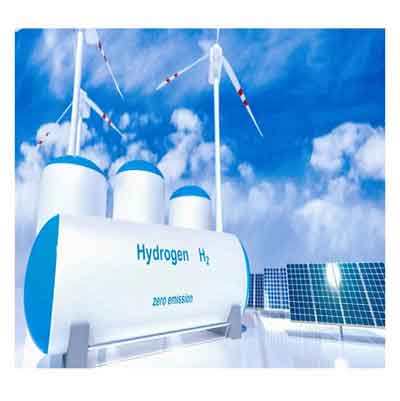Date: 14/03/2023
Relevance: GS-3: Indian Economy and issues relating to planning, mobilization, of resources, growth, development and employment.
Key Phrases: National Green Hydrogen Mission, Green Hydrogen Hubs, Green Hydrogen Transition, Strategic Interventions for Green Hydrogen Transition Programme (SIGHT), Strategic Hydrogen Innovation Partnership - SHIP
Why in News?
- One of the components of the National Green Hydrogen Mission Document is strategic interventions for green hydrogen transition, where ₹17,490 crore is to be allocated for domestic producers of electrolysers and green hydrogen.
- While this is commendable, the protocols and eligibility criteria for getting financing, etc., remain unclear. Given the urgency in the energy transition, more details need to be provided to relevant stakeholders.
Hydrogen:
- Hydrogen is used mainly to make chemicals such as fertiliser, and in oil refineries.
- Most hydrogen in the world today is made from natural gas or coal – methods associated with large carbon dioxide emissions.
- Green hydrogen is produced using renewable electricity such as solar and wind power.
How Is Green Hydrogen Made?
- Green hydrogen is made from water.
- Using renewable (“green”) electricity, equipment called electrolysers separates the hydrogen from oxygen in water (H₂O). The process is called electrolysis.
- Green hydrogen production emits no carbon dioxide, but the construction of renewable electricity infrastructure currently uses fossil fuels, which do emit carbon dioxide.
- Hydrogen has traditionally been made from non-renewable energy sources like coal (“black hydrogen”) and natural gas (“grey hydrogen”).
- When these methods are combined with carbon capture and storage, the hydrogen produced is known as “blue hydrogen”.
What Challenges Does Green Hydrogen Present?
- Although the costs of renewable power generation have been coming down, the cost of electrolysis is still not commercially competitive.
- Costs of transporting hydrogen are greater than oil-based liquid fuels, liquefied petroleum gas or liquefied natural gas.
- Ocean transport of hydrogen has to be at very low temperatures (-253℃).
- Petrol or diesel doesn’t need costly refrigeration and it is transported at ambient air temperature.
- Hydrogen carries only 25% of the energy that a litre of petrol does, making it much more expensive to transport and store the same amount of energy.
National Green Hydrogen Mission:
- The Mission states that India will develop green hydrogen production capacity of at least 5 million tonnes (MT) per annum with an associated renewable energy capacity addition of about 125 gigawatts (GW) in the country by 2030.
- It will also lead to a cumulative reduction in fossil fuel imports by over Rs 1 lakh crore and an abatement of nearly 50 MT of annual greenhouse gas emissions.
Components Of The Mission:
- Strategic Interventions for Green Hydrogen Transition Programme
(SIGHT):
- It will attract huge investments and encourage R&D, focussed on electrolysers, in the next few years.
- The Ministry of New and Renewable Energy (MNRE) will formulate the scheme guidelines for implementation of the respective components.
- Benefits of scheme:
- Creation of export opportunities for green hydrogen and its derivatives
- Decarbonisation of industrial, mobility and energy sectors
- Reduction in dependence on imported fossil fuels and feedstock
- Development of indigenous manufacturing capabilities
- Creation of employment opportunities
- Development of cutting-edge technologies.
- Green Hydrogen Hubs:
- The mission envisages development of green hydrogen hubs based on regions having proximity to refineries/fertiliser plants.
- The mission will also support pilot projects in emerging end-use sectors and production pathways.
- Regions capable of supporting large-scale production and/or utilization of hydrogen will be identified and developed as Green Hydrogen Hubs.
- Strategic Hydrogen Innovation Partnership (SHIP):
- A public-private partnership framework for R&D (Strategic Hydrogen Innovation Partnership - SHIP) will be facilitated under the mission.
- R&D projects will be goal-oriented, time-bound, and suitably scaled up to develop globally competitive technologies.
- A coordinated skill development programme will also be undertaken.
Way Forward For India:
- Short Term Goals:
- It will be prudent to finalise the locations taking into account ready availability of water, which in itself is a challenging proposition.
- In case the government is ambitious about introducing hydrogen fuel cell vehicles, the forthcoming MNRE guidelines need to provide a more detailed roadmap on incentives to OEMs for production of hydrogen-based vehicles and development of refuelling infrastructure.
- The roadmap for transition to hydrogen-based vehicles should be finalised after taking on board the learnings gained from EV transition.
- A major role will be played by the regulatory bodies as the sector cannot develop without a robust regulatory architecture, safety codes and standards.
- Storage of green hydrogen will also have to be scaled up and availability of funding should be ensured to enable newer and innovative modes of storage.
- Medium Term Goals:
- There will be a need for transportation of bulk green hydrogen.
- While the mission document has promised support to build pipelines for transportation of green hydrogen, it does not clarify whether new, dedicated pipelines will be developed or whether existing natural gas pipelines will be retrofitted for transporting green hydrogen.
- Either of the above will require crossing of various regulatory hurdles, legislative amendments to the statutes, new regulatory bodies, etc., which will be time consuming and may derail the mission targets.
Conclusion:
- India has made a good start, but there are still big problems that must be solved if it is to meet its decarbonization goals.
- The mission falls short of a definite commitment because there isn't much information on incentives, rules, or the government's plan to scale up related infrastructure.
Source: The Hindu BL
Mains Question:
Q. India has made a good start with the National Green Hydrogen Mission to meet its decarbonization goals. However, the mission falls short of a definite commitment in achieving the targets. Comment. (250 words).







